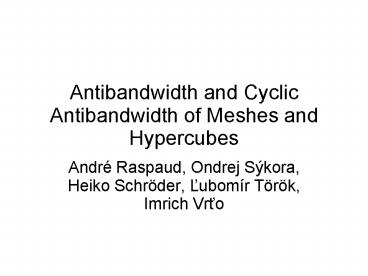Antibandwidth and Cyclic Antibandwidth of Meshes and Hypercubes - PowerPoint PPT Presentation
Title:
Antibandwidth and Cyclic Antibandwidth of Meshes and Hypercubes
Description:
Antibandwidth and Cyclic Antibandwidth of Meshes and Hypercubes ... Arborescent comparability. Treshold. graphs. (Donnely, Isaak, Hamiltonian powers in ... – PowerPoint PPT presentation
Number of Views:45
Avg rating:3.0/5.0
Title: Antibandwidth and Cyclic Antibandwidth of Meshes and Hypercubes
1
Antibandwidth and Cyclic Antibandwidth of Meshes
and Hypercubes
- André Raspaud, Ondrej Sýkora, Heiko Schröder,
Lubomír Török, Imrich Vrto
2
Dedicated to memory of Ondrej Sýkora
- V 12.5. 2005
3
Antibandwidth problem
- Consists of placing the vertices of a graph on a
line in consecutive integer points in such a way
that the minimum difference of adjacent vertices
is maximized. - Just another labeling problem (from graph theory
point of view)
4
Confusing terminology
- Originally studied under the term separation
number (Leung, Vornberger, On some variants of
the bandwidth minimization problem) - Dual bandwidth (Lin, Yuan)
- We propose (best and hopefully final) term
antibandwidth
5
Previous results
- NP-complete (Leung, Vornberger)
- Polynomially solvable for the complements of
- Interval
- Arborescent comparability
- Treshold
- graphs.
- (Donnely, Isaak, Hamiltonian powers in graphs)
6
Previous results
- Exact results for
- Paths, cycles, special trees, complete and
complete bipartite graphs - Also interesting for disconnected graphs.
- Exact values for graphs consisting of copies of
simple graphs.
7
Previous results
- m x n mesh, , (Miller, Pritikin,On
the separation number of graphs) - N-dimensional hypercube (Miller, Pritikin,)
8
Our contribution
- Upper bound method suitable for bipartite graphs
- Improving bounds for hypercubes and meshes
9
Our contribution
- Toroidal meshes
- Even n
- Odd n
10
Meshes upper bound
- Definition Let be a bipartition.
Minimal vertex boundary of a set is a
set of all vertices from having neighbour
in A. - Proof based on result of Bezrukov and Piotrowski
(minimal bipartite vertex boundary of mesh)
11
Meshes lower bound
- Showed in Miller, Pritikin, On separation number
of graphs
12
Even torus
- Optimal numbering for even torus
13
Odd torus
- Optimal numbering of odd torus
14
Hypercube
- Vertices of can be partitioned into sets
according to their
distance from the vertex 00...0. - Edges are only between and .
15
Cyclic antibandwidth
- The vertices are mapped bijectively into
such that the minimal distance, measured in
cycle, of adjacent vertices is maximized. - We provide
- General lower bound
- Values for meshes, tori and hypercubes
16
General bounds
- Upper bound
- Lower bound
17
Cyclic antibandw. of meshes
- m even, n odd, then
- Otherwise
18
Cyclic antibandw. of meshes
- Another optimal numbering of mesh comparing the
antibandwidth part
19
Cyclic antibandw. of meshes
- Way of proof
- To show that previous numbering is also
ab-optimal - Computing the length of the longest edge in this
labeling - Getting the lower bound value from general formula
20
Cyclic antibandw. of tori
- Even torus
- Odd torus
21
Cyclic antibandw. of hypercube
- Similar way of proof as for mesh
22
Conclusion
- Antibandwidth
- Improved bounds for meshes and hypercubes
- Results for toroidal meshes
- Cyclic antibandwidth
- General bounds based on antibandwidth
- Results for meshes, hypercubes and toroidal meshes
23
The End
- Thank You































